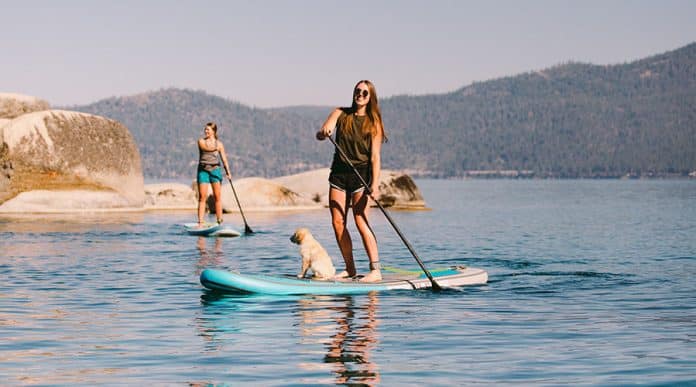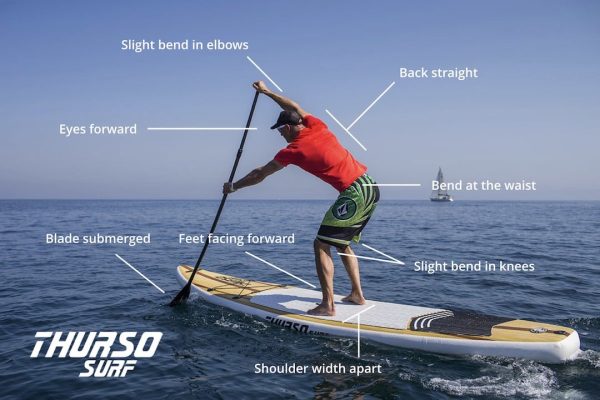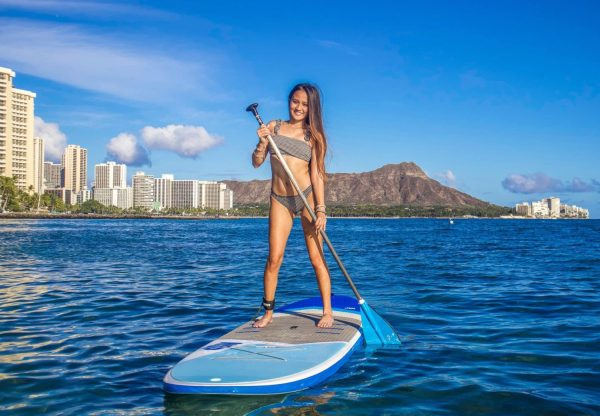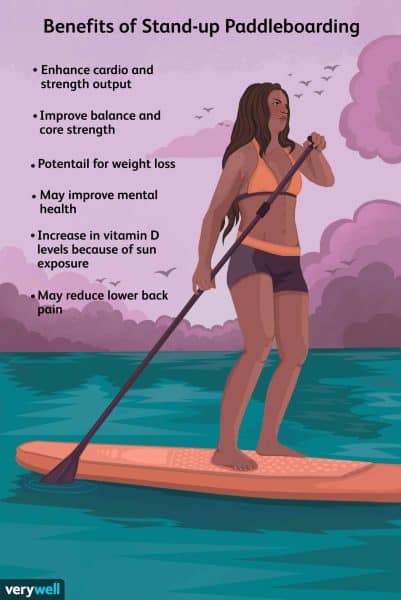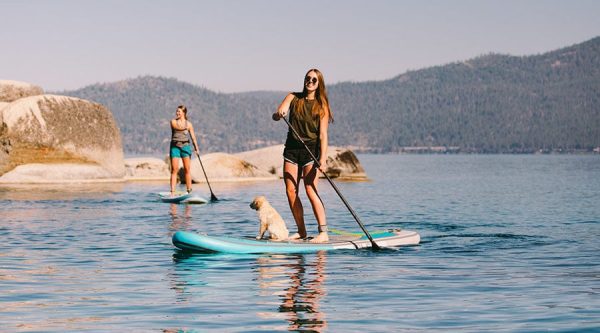Ah, the mesmerizing world of the SUP paddle board. Curiosity has brought you here, and we’re ecstatic to unravel the mysteries surrounding these incredible watercraft.
Picture yourself gliding effortlessly on pristine waters, the warm sun kissing your skin as you embark on an adventure fueled by balance and tranquility.
But what exactly is a SUP paddle board? Brace yourselves, for we are about to embark on an exciting voyage that will expand your horizons and ignite your desire to conquer the waves.
Get ready to step into a world where thrill and serenity collide as we uncover the essence of a SUP paddle board.
What is a SUP Paddle Board?
At its core, a SUP paddle board, also known as a stand-up paddle board, is a versatile and fun watercraft that allows individuals to stand, kneel, or sit on the board while using a long paddle to propel themselves through the water. It is essentially a blend of surfing and kayaking, providing a unique and enjoyable experience for people of all ages and skill levels.
Definition
A SUP paddle board is a type of board that is designed to be used as a platform for stand-up paddle boarding. It typically features a large deck area with enough space for a person to stand or sit comfortably, along with a long and sturdy paddle that is used to navigate and steer the board through the water. SUP paddle boards come in various shapes, sizes, and designs to cater to different paddle-boarding activities.
Origin and History
Stand-up paddle boarding has ancient roots and is believed to have originated in Polynesia over a thousand years ago. Polynesian fishermen used longboards and paddles to navigate the waters and catch fish.
However, the modern version of SUP paddle boarding as we know it today emerged in the 20th century in Hawaii, where surf instructors used the technique to maintain a better vantage point to monitor their students or take photographs. From there, the sport gained popularity and spread around the world.
Types of SUP Paddle Boards
Several types of SUP paddle boards are available, each designed with specific activities or preferences in mind. Here are some of the main types:
- All-Around: These boards are versatile and suitable for various conditions, making them perfect for beginners or those seeking a multipurpose board.
- Touring: Touring boards are longer and narrower, optimized for long-distance paddling and exploring lakes, rivers, or coastlines.
- Racing: Designed for speed and agility, racing boards are sleek, narrow, and often made from lightweight materials to maximize performance.
- Yoga and Fitness: These boards are broader and more stable, providing a secure platform for practicing yoga, Pilates, or other fitness activities on the water.
- Surfing: Specifically shaped for catching and riding waves, surfing SUP paddle boards are shorter, more maneuverable, and have a more pronounced rocker.
Components of a SUP Paddle Board
Understanding the various components of a SUP paddle board is essential to ensure that you choose the right board for your needs and preferences. Here are the key components to consider:
Board Shape
The shape of a SUP paddle board plays a significant role in its performance and stability. There are three main board shapes:
- Displacement Hull: These boards have a pointed nose and are designed for speed and efficiency in water or open ocean conditions.
- Planing Hull: Planing hulls are broader and flatter, providing stability and maneuverability for activities like surfing and recreational paddling.
- Hybrid Hull: Hybrid hulls combine elements of both displacement and planing hulls, offering a balance between speed and stability.
Materials
SUP paddle boards are typically constructed from various materials, each with its advantages and considerations:
- Epoxy: Epoxy boards are lightweight, durable, and provide excellent performance. They are commonly used for recreational and touring boards.
- Inflatable: Inflatable boards offer the convenience of easy storage and transport. Made from heavy-duty PVC, they are remarkably rigid and durable when inflated.
- Carbon Fiber: Carbon fiber boards are incredibly lightweight and rigid, perfect for racing or high-performance paddle boarding.
Fins
Fins play a crucial role in a SUP paddle board’s maneuverability and tracking ability. Most paddle boards have one center fin and two smaller side fins, but the number, size, and configuration can vary. Adjustable or removable fins allow for customization based on different water and activity conditions.
Deck Pad
A deck pad is a cushioned and textured surface on the top of the board, providing traction and comfort for the paddler’s feet. It helps prevent slipping and adds stability, especially during more active paddle-boarding activities.
Paddle
The paddle is a vital component of SUP paddle boarding, as it is used to propel and steer the board through the water. Paddles are typically adjustable in length and made from lightweight materials such as aluminum, fiberglass, or carbon fiber. Choosing the right paddle size and material is crucial for optimal performance and comfort.
Benefits of SUP Paddle Boarding
SUP paddle boarding offers a wide range of physical, mental, and environmental benefits. Here are some of the critical advantages of this famous water activity:
Full-Body Workout
Paddleboarding engages multiple muscle groups, including the core, arms, shoulders, back, and legs. Balancing on the board and paddling against the resistance of the water provides a fantastic full-body workout, helping to improve strength, endurance, and overall fitness.
Improves Balance and Coordination
Stand-up paddle boarding requires a high level of balance as you navigate on a floating board. Continued practice enhances core stability, coordination, and proprioception—the sense of positioning and movement of the body in space.
Low Impact Exercise
Unlike high-impact activities such as running or tennis, paddle boarding is a low-impact exercise that minimizes stress on the joints. This makes it an excellent option for recovering from injuries or joint issues.
Connects with Nature
Paddleboarding allows you to immerse yourself in nature and enjoy the peacefulness of the water. Whether you’re exploring serene lakes, meandering along scenic rivers, or gliding on ocean waves, you can connect with the natural environment and appreciate its beauty.
Great for All Ages and Fitness Levels
One of the most appealing aspects of paddle boarding is that it can be enjoyed by people of all ages and fitness levels. Whether you’re a seasoned athlete looking for a new challenge or a family seeking a fun and inclusive activity, SUP paddle boarding offers something for everyone.
Different Types of SUP Paddle Boarding
SUP paddle boarding is a versatile activity that encompasses various styles and disciplines. Here are some popular types of paddle boarding:
Recreational Paddling
Recreational paddling is the most common type of SUP paddle boarding. It involves leisurely exploring calm waters like lakes, ponds, or slow-moving rivers. This type of paddle boarding is perfect for beginners or those who simply want to relax and enjoy the tranquility of the water.
Touring
Touring paddle boarding involves more extended expeditions and exploring larger bodies of water, such as coastal areas, estuaries, or open oceans. It is a great way to see new places, experience nature up close, and challenge yourself with endurance paddling.
Racing
Racing paddle boarding is a highly competitive and exhilarating sport. Races can range from short sprints to long-distance endurance events, and they take place in various water conditions. Racing boards are designed to be lightweight, streamlined, and fast, maximizing speed and efficiency.
Yoga and Fitness
Paddleboard yoga and fitness have gained immense popularity in recent years. Practicing yoga or fitness routines on a SUP board adds an extra element of balance, core engagement, and mindfulness. It provides a unique and peaceful way to connect with your body, mind, and the water simultaneously.
Surfing
SUP surfing involves catching and riding waves on a paddleboard. It requires a combination of paddling, balance, and wave-riding skills. Surfing paddle boards are shorter, more maneuverable, and designed to handle the dynamic nature of waves.
Choosing the Right SUP Paddle Board
Selecting the right SUP paddle board is crucial to ensure an enjoyable and safe experience on the water. Consider the following factors when choosing your board:
Board Size and Volume
Board size and volume depend on weight, skill level, and intended use. Larger boards with high volume provide more stability, making them ideal for beginners or heavier individuals. Smaller boards are suitable for experienced paddlers who prioritize speed and maneuverability.
Board Shape and Width
As previously mentioned, different board shapes and widths cater to specific water activities and conditions. Consider the primary purpose of your paddle boarding, whether it’s recreational, touring, racing, or surfing, and choose a shape and width that aligns with your goals.
Materials and Durability
The materials used in the construction of SUP paddle boards impact their weight, durability, and performance. Epoxy boards are durable, lightweight, and offer excellent performance, while inflatable boards provide convenience and easy storage. Carbon fiber boards are premium options for those seeking maximum performance.
Weight Capacity
Ensure that the SUP paddle board you choose can support your weight and any additional gear you might carry. Check the weight capacity specifications provided by the manufacturer to ensure it aligns with your needs.
Transportation and Storage
Consider how you plan to transport and store your paddle board. Inflatable boards are highly portable and can be deflated and stored in a backpack, making them convenient for travel. Solid boards may require roof racks or a larger space for storage.
Safety Tips for SUP Paddle Boarding
While stand-up paddle boarding is generally a safe activity, it’s essential to follow some safety guidelines to ensure your well-being. Here are some essential safety tips:
Wear a Personal Flotation Device (PFD)
Always wear a properly fitting personal flotation device (PFD) when paddle boarding, especially when venturing into deep waters or unfamiliar environments. PFDs provide buoyancy and can be lifesaving in emergencies.
Check Weather and Water Conditions
Before heading out, check the weather forecast and water conditions. Avoid paddle boarding in inclement weather, strong winds, or rough waters. Be aware of any potential hazards such as rocks, strong currents, or marine wildlife.
Use a Leash
Attach a leash to your ankle or leg and secure it to the board. The leash ensures that you stay connected to the board in case you fall off, preventing it from drifting away and potentially causing dangerous situations.
Stay Aware of Your Surroundings
Always be mindful of other water users, such as swimmers, boaters, or surfers. Keep a safe distance from obstacles, other paddle boarders, and areas with heavy boat traffic. Be respectful of the natural environment and wildlife habitats.
Learn Proper Paddle Techniques
Proper paddle techniques improve your efficiency, reduce fatigue, and minimize the risk of injury. Invest some time in learning the correct paddle strokes and body positioning through instructional videos, lessons, or joining a group with experienced paddlers.
Getting Started with SUP Paddle Boarding
If you’re new to SUP paddle boarding, here are some steps to help you get started:
Finding an Appropriate Location
Choose a suitable location for your paddle-boarding adventure. Look for calm waters, such as lakes, reservoirs, or sheltered bays, that offer a peaceful environment and are free from strong currents or waves. Research local regulations and ensure you have proper access to the water.
Learning Basic Techniques
Start by learning the basic paddle techniques, such as the forward stroke, sweep stroke, and bracing. Practice your balance by kneeling or sitting on the board before progressing to standing up. Building a solid foundation of skills will make your paddle-boarding experience more enjoyable and safe.
Purchasing or Renting Equipment
Decide whether you want to purchase your own paddle board or rent one initially to try it out. Renting allows you to test different board types and sizes before investing in your own equipment. If you decide to buy, consult a knowledgeable dealer who can recommend the right board for your needs.
Taking Lessons or Joining a Group
Consider taking lessons or joining a paddle boarding group to enhance your skills and knowledge. Certified instructors can provide valuable guidance on paddle techniques, safety protocols, and introduce you to new paddle boarding locations. Additionally, paddling with a group can be more enjoyable and provide a sense of community.
Common Mistakes to Avoid
To ensure a smooth paddle-boarding experience, be aware of these common mistakes and take steps to avoid them:
Using the Wrong Size Board
Choosing the wrong size board can significantly impact your experience. Using a board that is too small or too large can compromise stability, maneuverability, and overall performance. Take into account your weight, skill level, and intended use when selecting the right board size.
Neglecting Safety Precautions
Always prioritize safety when paddle boarding. Neglecting safety precautions, such as not wearing a PFD, venturing into unsafe conditions, or paddling beyond your skill level, can lead to accidents or injuries. Continually assess the risks and make safety a priority.
Paddling with Poor Form
Improper paddle technique can lead to inefficient paddling, fatigue, and even strain or injury. Take the time to learn the correct form and practice it consistently. Focus on engaging your core, using your entire body for each stroke, and maintaining a relaxed grip on the paddle.
Failing to Dress Appropriately
Dress appropriately for the conditions and consider the possibility of getting wet. Wear comfortable, quick-drying clothing and appropriate footwear that provides good traction on the board. Apply sunscreen and wear a hat to protect yourself from the sun’s harmful rays.
Overestimating Your Skill Level
Be realistic about your skill level and choose activities and locations that align with your abilities. Overestimating your skill level and attempting advanced maneuvers or challenging conditions without the necessary experience can lead to accidents or mishaps.
Maintenance and Care for SUP Paddle Boards
Proper maintenance and care can extend the lifespan of your SUP paddle board and ensure optimal performance. Here are some tips:
Rinsing and Cleaning
After each use, rinse the board with fresh water to remove any salt, sand, or debris. Use a mild soap or SUP board cleaner to clean the surface gently. Avoid using abrasive materials or harsh chemicals that can damage the board’s finish.
Storage Tips
Store your paddle board in a cool, dry, and shaded area to minimize exposure to UV rays, extreme temperatures, and direct sunlight. If possible, store the board indoors or in a board bag. Also, avoid stacking heavy objects on the board to prevent warping or damage.
Repairing Damages
Inspect your board regularly for any signs of damage, such as cracks, dents, or delamination. If you notice any damage, address it promptly to prevent further issues. Small cracks or dings can often be repaired with epoxy or specialized repair kits, while significant damage may require professional repair services.
Replacing Parts
Over time, parts such as fins, deck pads, or leash attachments may wear out or become damaged. Replace these parts as needed to maintain optimal performance and safety. Consult with the manufacturer or a reputable dealer for compatible replacement parts.
Maintaining Proper Inflation
If you have an inflatable SUP paddle board, maintaining proper inflation is crucial for optimal performance and safety. Check the manufacturer’s guidelines for the correct PSI (pounds per square inch) and use a reliable pump with a pressure gauge to ensure accurate inflation.
In conclusion, a SUP paddle board is a versatile and exciting watercraft that offers a wide range of benefits for individuals of all ages and fitness levels. Whether you’re seeking a full-body workout, a peaceful connection with nature, or a thrilling surfing experience, SUP paddle boarding offers something.
By understanding the different types of boards, components, and safety guidelines, you can choose the right paddle board, embark on your paddle boarding journey, and enjoy the many pleasures it brings. Happy paddling!

